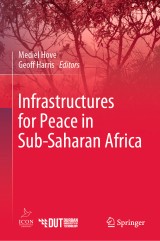Details

Infrastructures for Peace in Sub-Saharan Africa
|
60,98 € |
|
| Verlag: | Springer |
| Format: | |
| Veröffentl.: | 14.06.2019 |
| ISBN/EAN: | 9783030146948 |
| Sprache: | englisch |
Dieses eBook enthält ein Wasserzeichen.
Beschreibungen
<p></p><p>Cultures of violence are characteristic of many countries in sub-Saharan Africa and attempts to move towards cultures of peace have often proved difficult and ineffectual. And yet, the wide variations in levels of violence within and between countries show that it is not inevitable; rather, it is the result of choices made at individual, community and societal levels. This book examines the potential of peace infrastructures as vehicles to strengthen and spread progress towards cultures of peace.</p>
<p>Peace infrastructures vary hugely in sophistication and level. The examples examined in this book range from tiny structures which help resolve conflicts between individuals and within community organisations, peace committees which serve local communities, peace education and peace club programmes in schools, mediation mechanisms to prevent election violence and to ministries of peace to coordinate government and non-government efforts in peacemaking and peacebuilding. The overall finding is that the development of peace infrastructures at all levels has great potential to build cultures of peace.</p>
<p>1. It is the only book available which documents the experience and potential of nonviolence in post-independence sub-Saharan Africa.</p>
<p>2. It makes a persuasive case for the development of various peace infrastructures in order to make peace sustainable.</p>
<p>3. It explains how strategic planning can be utilised, both to bring about change and to institutionalise it.</p><p></p>
<p>Peace infrastructures vary hugely in sophistication and level. The examples examined in this book range from tiny structures which help resolve conflicts between individuals and within community organisations, peace committees which serve local communities, peace education and peace club programmes in schools, mediation mechanisms to prevent election violence and to ministries of peace to coordinate government and non-government efforts in peacemaking and peacebuilding. The overall finding is that the development of peace infrastructures at all levels has great potential to build cultures of peace.</p>
<p>1. It is the only book available which documents the experience and potential of nonviolence in post-independence sub-Saharan Africa.</p>
<p>2. It makes a persuasive case for the development of various peace infrastructures in order to make peace sustainable.</p>
<p>3. It explains how strategic planning can be utilised, both to bring about change and to institutionalise it.</p><p></p>
Part I: Violence in Sub-Saharan Africa.- 1 Putting a tape measure around violence in Sub-Saharan Africa.- 2 The biggest violence: a case study of gender-based violence in urban Bindura, Zimbabwe. Part II: The Case for Nonviolence.- 3 Violence or Nonviolence? A comparison of costs and effectiveness.- 4 Why non-violent movements failed in Zimbabwe, 2000-2015. Part III: Nonviolent Initiatives.- 5 Collaborative conflict resolution: a case study of conflict transformation in peri-urban Zimbabwe.- 6 Collaborative conflict resolution: a case study of women's self-help groups in north-western Zimbabwe.- 7 Building peace through local peace committees: African experiences.- 8 Local peace committees and election violence in Burundi, 2015.- 9 The necessity of peace education in Zimbabwe.- 10 Peace clubs in schools: African experiences.- 11 Mediating post-electoral violence in Kenya, 2007-2008.- 12 Establishing Ministries of Peace in Sub-Saharan Africa.- Part IV: Future Challenges.- 13 Youth bulge: a blessing or curse to Zimbabwe's peace?- 14 The challenges of climate change for nonviolence.- Part V: Final Reflections.- 15 Let a thousand peace infractructures bloom.
<p></p><p>Cultures of violence are characteristic of many countries in sub-Saharan Africa and attempts to move towards cultures of peace have often proved difficult and ineffectual. And yet, the wide variations in levels of violence within and between countries show that it is not inevitable; rather, it is the result of choices made at individual, community and societal levels. This book examines the potential of peace infrastructures as vehicles to strengthen and spread progress towards cultures of peace.</p>
<p>Peace infrastructures vary hugely in sophistication and level. The examples examined in this book range from tiny structures which help resolve conflicts between individuals and within community organisations, peace committees which serve local communities, peace education and peace club programmes in schools, mediation mechanisms to prevent election violence and to ministries of peace to coordinate government and non-government efforts in peacemaking and peacebuilding. The overall finding is that the development of peace infrastructures at all levels has great potential to build cultures of peace.</p>
<p>1. It is the only book available which documents the experience and potential of nonviolence in post-independence sub-Saharan Africa.</p>
<p>2. It makes a persuasive case for the development of various peace infrastructures in order to make peace sustainable.</p>
<p>3. It explains how strategic planning can be utilised, both to bring about change and to institutionalise it.</p><br><p></p>
<p>Peace infrastructures vary hugely in sophistication and level. The examples examined in this book range from tiny structures which help resolve conflicts between individuals and within community organisations, peace committees which serve local communities, peace education and peace club programmes in schools, mediation mechanisms to prevent election violence and to ministries of peace to coordinate government and non-government efforts in peacemaking and peacebuilding. The overall finding is that the development of peace infrastructures at all levels has great potential to build cultures of peace.</p>
<p>1. It is the only book available which documents the experience and potential of nonviolence in post-independence sub-Saharan Africa.</p>
<p>2. It makes a persuasive case for the development of various peace infrastructures in order to make peace sustainable.</p>
<p>3. It explains how strategic planning can be utilised, both to bring about change and to institutionalise it.</p><br><p></p>
<p>First book documenting the experience and potential of nonviolence in post-independence sub-Saharan Africa</p><p>Persuasive case for the development of various peace infrastructures in order to make peace sustainable</p><p>Explains how strategic planning can be utilised, both to bring about change and to institutionalise it</p>
Diese Produkte könnten Sie auch interessieren:

Inclusión educativa de niños, niñas y adolescentes migrantes venezolanos, en Colombia

von: Douglas Jiménez

15,99 €
















